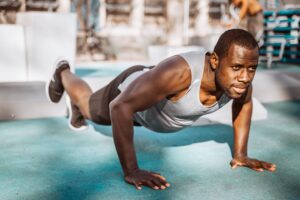Push-ups, a timeless and effective bodyweight exercise, have secured their place in fitness routines worldwide. However, like any popular exercise, push-ups come with their fair share of myths and misconceptions. Let’s unravel some of these common misunderstandings and set the record straight.
Myth 1: Push-Ups Only Work the Chest
While push-ups are indeed excellent for targeting the chest muscles (pectoralis major), they are far from a one-dimensional exercise. Push-ups engage multiple muscle groups, including the shoulders (deltoids), triceps, and core. The dynamic nature of push-ups requires stability from various muscle groups, making them a compound exercise that contributes to overall upper body strength.
Myth 2: Push-Ups are Only for Upper Body Strength
Contrary to popular belief, push-ups are a full-body exercise. The plank position and the movement involved engage the core muscles, helping improve core strength and stability. Additionally, push-ups require activation of the lower body muscles, including the quadriceps and glutes, to maintain a straight body position. So, the next time you perform push-ups, pay attention to your entire body working in unison.
Myth 3: Push-Ups Can’t Build Significant Muscle Mass
While it’s true that push-ups primarily target muscular endurance, they can contribute to muscle hypertrophy when performed with the right intensity and volume. Progressive overload, achieved by increasing the number of repetitions or incorporating variations, challenges the muscles and promotes growth. Push-ups may not replace heavy weightlifting for mass gain, but they are a valuable tool for building functional strength and lean muscle.
Myth 4: Push-Ups Hurt the Shoulders
Some individuals avoid push-ups due to concerns about shoulder pain. However, when performed with proper form, push-ups are generally a shoulder-friendly exercise. Keeping the shoulders away from the ears, maintaining a straight line from head to heels, and avoiding excessive flaring of the elbows are essential components of correct push-up form. If you experience shoulder pain, it’s crucial to assess your form and, if necessary, consult a fitness professional or healthcare provider.
Myth 5: Push-Ups Every Day Lead to Overtraining
The idea that daily push-ups inevitably lead to overtraining is a misconception. The human body is resilient and adapts to stress with adequate recovery. However, the key is to vary your routine and intensity. Performing push-ups daily without allowing for recovery may lead to overuse injuries or burnout. Incorporating rest days, modifying intensity, and including different exercises in your routine can help prevent overtraining.
Myth 6: Push-Ups Alone Are Sufficient for a Complete Workout
While push-ups offer numerous benefits, relying solely on them for a comprehensive workout is a mistake. A well-rounded fitness routine should include a variety of exercises to target different muscle groups and movement patterns. Incorporate cardiovascular exercise, lower body strength training, and flexibility exercises to achieve overall fitness. Push-ups can be a valuable component of your routine but should be complemented by a diverse range of activities.
Myth 7: Push-Ups are Only for Men
Push-ups have no gender bias; they are a universally beneficial exercise for both men and women. The idea that push-ups are exclusively for men is outdated and unfounded. Women can benefit significantly from incorporating push-ups into their fitness routines, enhancing upper body strength, core stability, and overall muscular endurance.
Myth 8: Push-Ups Are Ineffective for Advanced Fitness Levels
Regardless of your fitness level, push-ups can be adapted to provide a challenging workout. Advanced variations such as one-arm push-ups, plyometric push-ups, and handstand push-ups require increased strength and skill. By progressing to more challenging variations, individuals at advanced fitness levels can continue to derive benefits from push-up variations.
Conclusion
Push-ups, when performed correctly and integrated into a well-rounded fitness routine, offer a plethora of benefits. Dispelling these common myths allows individuals to embrace push-ups as a versatile and effective exercise for building strength, endurance, and overall fitness. Whether you’re a beginner or an advanced fitness enthusiast, understanding the true nature of push-ups empowers you to make the most of this classic exercise in your fitness journey. Remember, form is key, and consistency is your ally on the path to push-up proficiency.



